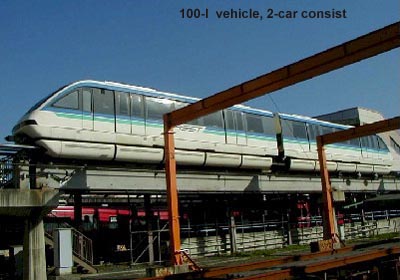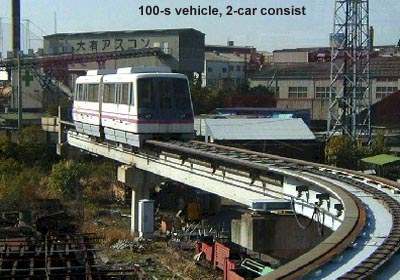Assessment of CHSST Maglev for U.S. Urban Transportation
FTA Report No. FTA-MD-26-7029-2002.1, July, 2002, 118 pp.
Executive Summary
The Federal Transit Administration (FTA) is examining the possibility of introducing magnetically levitated slow speed vehicles (under 160 kph (100 mph)) for urban mass transportation in the United States. Maglev has several advantages over conventional transportation, such as existing automated guideway transits (AGT), Light Rail system, and bus. These include: reduced travel time, congestion mitigation, decreased pollution, reduced noise, increased ride comfort, better grade-climbing capability, improved energy efficiency, reduced maintenance, and possibly, competitive capital, operating and life cycle cost.
The evaluation led to the following major conclusions:
· The CHSST system is a tested and demonstrated low-speed system that is being readied for commercial application. It is based on mature Electromagnetic Suspension (EMS) technology.
· The CHSST system is intended for operation at 100 kph on the Aichi Prefecture proposed route of approximately 9.5 km in Japan. The system can be run at 130 kph with some upgrades. To reach speeds of 160 kph, a major redesign and development is required.
· The CHSST Maglev is expected to be within safe limits of magnetic and electrical field strengths. Its noise level with its present permissible speed in Japan (100 kph) is reasonably low.
· The system can negotiate 7% gradients, although with significant speed degradation.
· The smaller 100-S vehicle can negotiate 25 m radius curves, but the larger 100-L needs at least a 50 m radius curve.
· The CHSST has zero-speed levitation capability and can stay levitated at the stations, but its levitation gap while running is on the order of 6 mm. All EMS systems are inherently unstable, requiring continuous servo-controlled stabilization of the gap.
· According to the Japanese estimates, it can be cost competitive with Light Rail systems. Similar estimates for U.S. conditions have not yet been made.
At the present speed limit of 100 kph, the system may find application in the United States. If the system is upgraded and tested at a speed of at least 130 kph, as discussed in this report, it can find application on more urban and suburban routes in the United States.
Applicability of CHSST Maglev Technology for U.S. Transportation
FTA Report No. FTA-MD-26-7029-2003.1, June 2003, 57 pp.
The Federal Transit Administration (FTA) is examining the possibility of introducing magnetically levitated low speed vehicles for urban transportation in the United States to reduce road traffic congestion. For this purpose, the FTA is evaluating existing technologies and also developing alternate technologies within the realm of Maglev. One of the existing technologies currently under deployment is the Chubu HSST in Japan. To assess its technical merits and applicability to U.S. scenarios, in February, 2003 the FTA sent a team of experts to Japan, including a select group of representatives from U.S. transit agencies.
This report is based on the FTA team visit to CHSST in the Nagoya facility where the Maglev vehicles are being tested on a special test track, and also to facilities elsewhere in Japan where the vehicles and linear motors are being manufactured. The visit involved discussions with the CHSST technical staff and representatives of Aichi Prefecture (similar to state government) in Nagoya, Japan and the national Department of Land, Infrastructure, and Transportation (DLIT), which assisted in funding the project.
A previous delegation to Japan in 2002 focused on the HSST 100L Series vehicle and prepared a report that compared the HSST performance characteristics with FTA goals. A major conclusion of the report is that although the vehicle does not satisfy all the FTA goals, the vehicle and Maglev technology are applicable for certain scenarios in the U.S. For many other scenarios it is desirable to upgrade the vehicle, particularly to achieve higher peak speeds (to 200 km/h from the existing 100km/h). The existing vehicle should also be examined and modified, if necessary, for improved egress, crashworthiness, fire safety, and ADA requirements, which are mandatory in the U.S.
The focus of the recent visit was on the 200 km/h speed vehicles, for which the CHSST has specifications and preliminary design concepts. In addition, clarifications were sought on the mandatory requirements referred to above. The vehicle and motor manufacturing infrastructure for the CHSST was also examined. The current construction for a deployment on a 9 km track in Nagoya, to be operational in 2005, was also monitored by the FTA team during the one week stay in Japan.
The following conclusions are drawn in this report:
· The current CHSST Maglev technology has potential application in U.S. urban transportation, particularly for short distance routes with close station spacings. For long distance routes with long station spacings, the CHSST Maglev vehicle needs technical enhancements requiring developmental work.
· The CHSST technology has been demonstrated and is mature, with the necessary manufacturing support. It is in a state of readiness for deployment in the U.S. on short station spacing scenarios of less than two miles, typical of today’s urban application, for efficient trip times.
· The advantages of CHSST Maglev over traditional transit systems such as Light Rail include public acceptance due to low noise, low vibration, superior ride quality, superior grade climbing, and low energy consumption.
The U.S. need to examine methods of cost reduction on the CHSST guideway for adoption in urban transportation scenarios, and may consider joint projects with CHSST for technology improvements and implementation in U.S. urban scenarios.

